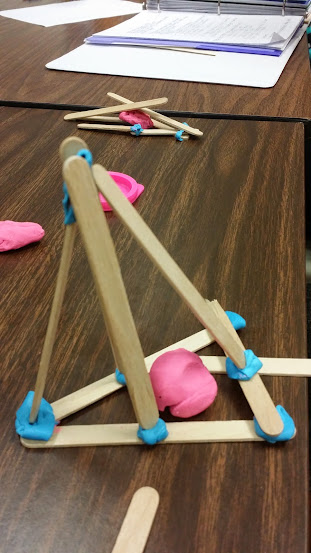BIG IDEA
Using weather instruments.
FOCUS QUESTION
How is an anemometer used to measure wind?
Teaching point: show a picture of an anemometer to the class and introduce the big question, “How do you think this can measure wind speed?”
PREDICTION/ HYPOTHESIS
I think the stronger the wind is, the faster the cups will spin.
I think we can use the cups to figure out what direction the wind is coming from.
Teaching point: make a chart on the board with the whole class. Allow class to make predictions. Include our predictions below also.
PLANNING
Materials
4 small plastic cups per student (plus extra for mistakes)
Masking tape
1 straight pin or thumbtack per student
1 pencil with an eraser per student
One nail
A couple of hole punches
Teaching point: hand out materials, guide students step by step through building the anemometer. Teacher punches the hole with the nail and helps with hole punches)
First we took two straws and joined them together to make one long straw. We did that twice to have two long straws.
Then we punched two holes in each cup, in a straight line, slid the straws through the holes and taped the straws in the middle. The teacher made a hole with a nail where the straws were taped. Then we pushed our thumbtack into the hole and into the eraser on the pencil.
Next we took them outside to see if they would turn in the wind.
DATA
Trial
|
How Many Rotations?
|
Direction of the Wind
|
Strength of the Wind
|
1
|
0
|
Could not tell
|
Extremely weak
|
2
|
3
|
Could not tell
|
low
|
3
|
10
|
Could not tell
|
Fairly strong
|
CLAIMS AND EVIDENCE
Claim
|
Evidence
|
I think the stronger the wind is, the faster the cups will spin.
|
We found this to be true. As the wind got stronger the cups spun faster.
|
I think we can use the cups to figure out what direction the wind is coming from.
|
It was hard to tell which way the wind was blowing. The cups only turn in one direction.
|
Teaching point: ask students to revisit the predictions page and report on what they found when the went outside. Write their claims and evidence in chart format on the board)
CONCLUSION/REFLECTION
We learned that an anemometer measures the wind speed or volume.
In this investigation we discovered that the faster the cups were spinning, the harder the wind was blowing, which confirmed our first hypothesis. When the wind stop blowing the cups stopped spinning, and when the wind was blowing softly the cups were moving slowly.
Our other hypothesis claimed that we would be able to determine what direction the wind was blowing was incorrect. It was hard to tell what the direction the wind was blowing, because the cups only spinned one way. We would need another instrument to be able to tell what direction the wind is blowing. This experiment reminded me of a water mill that I have seen before. The mill rotates because the weight of the water coming in and pouring out of the mill, but the mill is different than the anemometer because it does not measure anything.
Teaching point: Have students synthesize this into one-three sentences based on their learning, their claims and evidence. Write on the board)
QUESTIONS
What could we do to see how fast the wind was actually blowing by looking at our anemometer?
Would bigger cups spin faster?
Can power be generated by anemometers spinning in the wind?
Teaching point: asks students which questions they still have? Write them on the board.
LITERARY CONNECTIONS
Experiments on the Weather by Zella Williams
The Amateur Meteorologist Exploration and Investigations by H. Michael Mogil and Franklin Watts
References
Frugal Fun for Boys. (2015). Make an Anemometer to Observe Wind Speed - Frugal
Fun For Boys [Web log post]. Retrieved from
Weather Scope. (2007). [drawing]. Retrieved from
Robinson Cup Anemometer [Drawing]. (n.d.). Retrieved from
